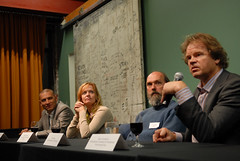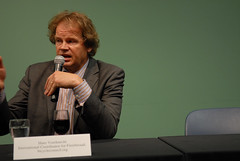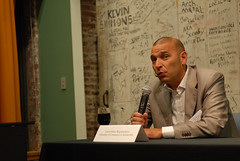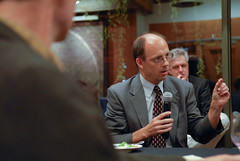Earlier this month, I attended a dinner and panel discussion hosted by a fledgling coalition of bicycle transportation planners, bureaucrats, and bigwigs from across the country. Bike program coordinators from major cities like Boston, San Francisco, Chicago, New York, and Minneapolis were joined by the executive directors of the two largest and most powerful bike advocacy groups in America; the League of American Bicyclists and Bikes Belong.
Why were all these bright biking minds in the same room? Besides their joint (and evolving) effort to promote more bike-centric infrastructure guidelines, they wanted to hear advice from their European counterparts.
Lucky for them, it just so happened that Metro was hosting four experts from Europe as part of their recent Transatlantic Active Transportation Workshop. Below are brief bios of the European delegates (with the perspective they represent in parentheses), followed by highlights from the night’s Q & A session.
I think you’ll appreciate that candid advice and insights that were shared.

Adelheid Byttebier (policy and politics)
An elected member of the Brussels regional parliament from 1999 until 2009, representing the Green party.

Niels Jensen (engineering)
A senior traffic planner working with cycling policy, strategies and planning in the Traffic Department of Copenhagen.
Hans Voerknecht (advocacy, activism)
The International Coordinator for Fietsberaad, a subsidiary of the Dutch Knowledge Center on Traffic and Transport (KpVV), which is a knowledge center for expertise on cycling and related subjects (they also run the website BicycleCouncil.org).
Geert-Pieter Wagenmakers (business)
A senior advisor to the Chamber of Commerce of Amsterdam on issues related to traffic and transportation.
First up with a question for the panel was Portland’s City Traffic Engineer Rob Burchfield. He asked: What are factors we need to be mindful of if we aspire to reach your levels of biking?
Niels Jensen:
“Copenhagen built their first cycle track in 1905… they have 100 years of building their infrasructure. The cycle tracks are the backbone of the infrastructure. it gives a safe place to cycle both from a statistical point-of-view and a feeling of safety.”
Hans Voerknecht:
“If they feel safe they will cycle. The solution chosen in nearly all U.S. cities is that you have cycle lanes next to parked cars and next to traffic and I think that the people who might want to cycle but don’t do it yet… they would think it’s too close to this fast-moving traffic.
Also your national guidelines [referring to AASHTO and the Manual of Uniform Traffic Control Devices, which is the bible for roadway design standards developed by highway builders that has become a thorn in the side of innovative bikeway planners]… Were these guidelines a means or an end? I think you consider them an end to the conversation but they should be a means to get more people cycling.
Saying “well those are the guidelines” is like a detective looking for a murder weapon and saying well, “I can’t look in the bed room because the guidelines say I can’t trespass on the privacy of the people.” They [the MUTCD guidelines] are “completely counterproductive”.
Also, look to children. When I ask my kids, ‘should we go by car or bike?’ they always want to take the bikes. But here in the U.S., parents prevent children from doing what they like. Some of the reasons are valid, but you sacrifice the pleasure of your children… for the addiction to your cars. Is that really the price you want to pay?”
Michelle Poyourow from the Bicycle Transportation Alliance asked a question about how to balance consistency (in design) versus pushing for innovation:
AASHTO guidelines make things consistent but also make it hard to innovate… Unlike in Europe where bike lanes change from green, blue or red, as you travel the countryside. If the designs are good, does it matter if someone from Chicago is driving in Texas? Do you think consistency is very important or do you think good designs can vary from place to place?
Hans Voerknecht:
“In the Netherlands there are of course guidelines but all engineers are challenged every day to find solutions… There is a lot of freedom for trying out things and I think that’s important. For things that are common already, you should use the consistency. But if you’ve got problems you should try out a new policy. In the Netherlands, the politician says “I want to promote cycling” so the engineers and policy makers come up with the plan.”
Adelheid Byttebier:
“I believe a mix of consistency and innovation must be allowed. There is an EU regulation passed in 2001. It was decided every street that’s at least 3 meters wide (about 10 feet) should accept contraflow cycling. The greens were in the majority so we pushed for that. We have now done studies and found that after four years it is safer with more paint. The signage is obligatory and regulated, but the pavement markings we can get creative with.”
Andy Clarke, the executive director of the League of American Bicyclists asked a two-part question:
Where do your get your inspiration and what have you seen [in America] so far that you’ll take back and share with your colleagues?
Niels Jensen:
“I think the inspiration in Copenhagen came with the big cyclist demonstrations that first happened in the 1980s. It was tens of thousands of people showing up demanding better bicycling facilities. It surprised politicians… so they decided something should be done and then they told the engineers to do it. There was some resistance in the beginning, but they had to do what they were told to do.”
Hans Voerknecht:
“In the Netherlands, politicians want to be the best bicycle town. For example Rotterdam is known as a bad bike town so they are recommending to take immediate action [they have ONLY 20% bike mode share].
Cycling also provides the Netherlands a strategic place in the climate, health, sustainability, and obesity debates. For example, Harvard wants to do research on how/if cycling can help prevent Alzheimers and the only place they can do the research is in the Netherlands because we’re the only place where enough older people are riding.”
Adelheid Byttebier:
“What i could really take back to Brussels is the green wave — the signal timing [on Stark Ave. in downtown Portland] is really superb.”
Bike Gallery owner Jay Graves asked:
One of the schools of thoughts here is that all we have to do is put in cycle tracks and we’ll get to 30-35% mode split. Is it really just that easy?
Niels Jensen:
“I don’t think it’s just that easy… I don’t think you would reach those numbers. I think our two societies are so different. You are depending so much on cars and it’s not so easy to change that. In Copenhagen, cars are expensive the petrol is expensive and many Copenhageners don’t need/have a license [to drive]… You are in a completely different situation. I mean, i don’t know how you should handle it.”
Hans Voerknecht:
“The thing is, you want to have cycling go mainstream… You have really succeeded when you don’t have these events anymore [like David Byrne at the Bagdad, which they all attended]. If you would organize these events in the Netherlands, no one would come…
And helmets… I don’t think you should forbid people from wearing helmets, but stop promoting it. Doesn’t it say something to you that in cities like Denmark only 10-15% of the people wear a helmet?”
Jeff Olson, a planner with Alta Planning and Design asked:
If you were able to ask Mayors of large cities in the U.S. to go and ask Congress for anything, what should they ask for?
Niels Jensen:
“I’d ask for money”
Hans Voerknecht:
“Two things: Change the guidelines, and second would be parking. Change dramatically the way of parking. Allow no more parking in the streets 1/2 mile from homes and businesses so you remove all the short trips and people will know they don’t have the car in front of their door. You would also remove all this traffic noise and small particles in the air.
I don’t know if it’s true but I’ve heard Americans even use a car to post a letter around the corner. If you had to walk a 1/2 mile to get your car you wouldn’t do that anymore.”
City Traffic Engineer Rob Burchfield got the last question of the night (and it was a good one):
I want to ask about pricing the use of the automobile. In most of your countries and cities, it’s expensive to purchase a car, to get fuel, to park — and in addition, you’ve put restrictions on cars within your city. It’s simply not convenient to drive.
In the the U.S., that pricing is very absent. There’s very little political will to disincentivize the use of the automobile. We’re concerned that our goals for reaching higher mode split will be difficult to reach because of our inability to put price disincentives on car use. Is that a valid concern? How is it that you’ve come to have that political will?
Geert-Pieter Wagenmakers:
“While in Beaverton I saw all of these enormous rooms for all these cars… even a parking garage for cars! I asked, are you subsidizing this? If so, it’s socialism. You’re subsidizing a parking lot… and that’s out of the mouth of somebody from the business community.
In our country, every square meter is money and you have to use it as good as possible so it gains as much money as possible. And I know one thing, parking cars is not a beneficial way of industry.
Why are the tariffs for parking in the city so high [In Amsterdam, they’re about $7 an hour, 24-hours a day]. First, it’s good for quality of life and second, for the people who really need to be in the city — like the people with their big Mercedes to go to the Gucci shop, or the business man who needs to go to an important meeting — now he has a place to park. In the old days, when parking was much cheaper, they had to search for a spot… so that’s good for business.”
Hans Voerknecht:
“One of the things is, if you would ask the Dutch public, ‘Would you rather pay less tax on your cars and pay less tax on your fuel,’ everybody would say ‘Oh yes!’ But the thing is we don’t ask them!
You shouldn’t ask all the time, ‘Do you want to spend money?’ Of course they say no. The thing is, if people are so narrow-minded, you need politicians… Democracy is not about doing the will of the people; it’s about choosing the best men and women out of the people who make the wisest decisions.
The costs of maintaining a road network is high and the users should pay for them… there’s no such thing as a free lunch.
Fees work very well to affect the behavior of the people, but it also works well is to reward the people who do the desired behavior. In some cities, they have sort of a reverse congestion pricing: People whose cars aren’t seen in rush hour get up to 8 euros a day.”
Adelheid Byttebier chose not to directly answer the question, but instead shared some general advice for how to promote bicycling:
“Maybe we should look for best practices not only in the field of mobility or cycling but best practices that have worked in a completely separate field. What we have with our mobility problem is the means of transport itself — the car. It’s very socially accepted, it’s — certainly here in America — not so expensive, you can get everywhere with one, etc… On the other hand we know it’s not good for your health or for society in terms of sustainable living and so on.
This reminded me of the debate we’ve all had on smoking.
My father was a smoker and it was very social, not so expensive and it was about having a good time. But, at a certain moment, the decision was made to no longer have ads for smoking and to make it an issue and talk about the health aspects. it’s been a long struggle, but in Belgium we’ve just had a report on health and heart attacks and they’ve found we’ve had great results since we’ve restricted smoking.
Perhaps that experience will give us a good inspiration to try and do it a similar way concerning better modes of being mobile.”
As Portland (and the rest of America) strives to emulate places like Copenhagen and Amsterdam, we’ll come face to face with some of these hard truths about our transportation culture. Are we ready to face them? Are there limits to how much we can emulate Northern Europe?
These questions are sure to play out in the coming years.
Related Event:
As reception for the Dreams on Wheels exhibit, the Oregon Manifest is hosting Portland Mayor Sam Adams and “Denmark’s leading bicycle ambassador” Mikael Colville-Andersen of Copenhagenize for what is sure to be a provocative conversation about “whether Portland should aspire to be more like Copenhagen”. Author Jeff Mapes will moderate. Tickets are $10. More details and ticket purchasing can be done here.





